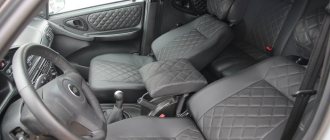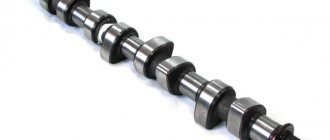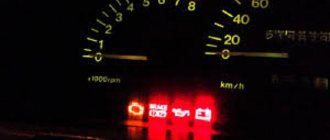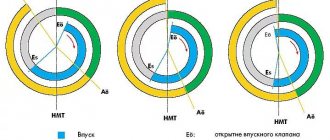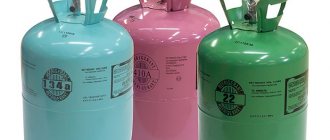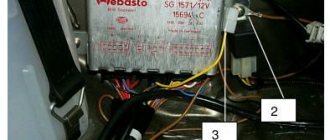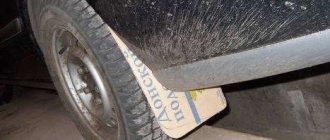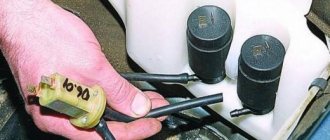Is it advisable to install air suspension on a car?
Let's figure out what air suspension is and whether it's worth spending money on it.
Air suspension is a shock absorption system that allows you to automatically change the vehicle's ground clearance without the use of physical force.
This type of suspension is considered a universal option, which allows it to be mounted on both cars and trucks.
Installing air suspension guarantees a number of advantages:
- Changing the vehicle's ground clearance. To increase (decrease) the clearance, it is not necessary to change the springs or make major alterations. A few minutes of adjustment and the suspension sets the desired ground clearance.
- Smooth ride off-road. The disadvantage of spring shock absorbers is their sensitivity to uneven roads, which requires maximum attention from the person behind the wheel. With air suspension it is simpler - vibrations are compensated, which reduces vehicle shaking to almost zero.
- Comfort and controllability. Hard or soft springs have strengths and weaknesses. The former are suitable for asphalt roads, and the latter for off-road use. The advantage of air suspension is that it smooths out the disadvantages of different springs.
- No drawdown. The air suspension guarantees optimal ground clearance even at maximum load, as the ground clearance can be easily adjusted to the required value. So it doesn't matter how many passengers are inside the vehicle.
Before deciding to install such a suspension, it is worth considering a number of its disadvantages:
- The cost of air suspension is high, which discourages car enthusiasts. The money is used to purchase air bags, an air receiver, a compressor and other devices.
- Not maintainable. If any of the system elements fails, the entire unit will have to be replaced. This leads to additional costs, which not all car enthusiasts are ready for.
- Insufficient resistance to the negative effects of “chemicals” on the roads, frost, heat, and so on. Such factors lead to a decrease in the resource of the node. And if alcohol poured into a pillow can save you from the cold, then only the installation of original and expensive products will protect you from “chemicals” on the road.
The principle diagram of the air suspension looks like this.
Another scheme.
Air suspension control
The control unit is responsible for controlling the air suspension. Usually there are up to 8 buttons on it, each of which allows you to adjust both one specific strut and all shock absorbers in the complex. To do this, a controller is installed in the car interior, which transmits indicators from each airbag to the driver. Depending on the road situation, the driver can either increase or decrease the air pressure in the airbag, while the vehicle’s ground clearance will be increased or decreased.
Convenient display shows the pressure in each pillow
In order to turn off the air suspension, just press the corresponding button on the controller. Immediately after turning off, the system will set the average ground clearance, and the pillows will begin to work like regular shock absorbers on springs.
Installing air suspension on a VAZ 2110
Statistics show that car enthusiasts are more dissatisfied with the product of the domestic automobile industry. That is why the number of tuned “nines”, “tens” and other AvtoVAZ models is growing on the roads.
The principle of selecting components and installing air suspension for different VAZ models is almost identical.
For example, let's take the 2110 model.
So, to install the air suspension yourself, you will need the following material:
1. Racks.
Here it is allowed to use factory racks of the SAAZ type with oil filling. Purchase costs - 8 thousand rubles.
2. Air suspension cushions.
As an option, use pillows from Scania’s fourth generation, mounted under the cab of a truck. The issue price is 3 thousand rubles per piece. For example, these.
3. Receiver for air suspension.
A gas cylinder from the “nine” is suitable as a receiver. It has several advantages - the presence of a check valve, resistance to pressure up to 22 atmospheres, capacity up to 45 liters.
All these advantages indicate that the car will rise faster. The main disadvantage is the large mass.
As an alternative, a 25-liter cylinder from KamAZ can be used. The cost of purchasing a cylinder is 2.5 thousand rubles.
4. HBO valves.
To operate, you will need two pairs of solenoid valves. Pay attention to quality. Devices must withstand up to 25 atmospheres. Price - 350 rubles per piece.
5. Fittings and tubes.
The best option is the use of PVC pneumatic tubes used in the brake systems of trucks. Tubes are selected with a diameter of 6 and 8 mm. The first (at 6 mm) are mounted from the intake valves to the receiver, and the second (at 8 mm) - from the compressor to the receiver. The asking price is 35 rubles per meter.
6. Compressor.
An excellent option is to install a Berkut P 20 series compressor costing 4,950 rubles. Advantages: high pumping speed, reliability.
7. Management.
To control the valves, a special system was used, controlled by three toggle switches. The first starts and stops the rear circuit, the second the front circuit, and the third controls the compressor.
8. Pressure gauge.
A pressure gauge, as well as a moisture and oil separator, are installed between the receiver and the compressor. The installation location in the cabin is determined independently. The issue price is 80 rubles per piece.
Before starting work, it is worth considering the following points:
- To manufacture the body, you will need the help of a specialist turner. Without this, it will not be possible to fit the pillow (has a diameter of 4.5 cm) tightly onto the car body. In addition, you will have to make several sealing washers;
- On the boots at the front of the car, you will have to remove the spring cups. In this case, the springs installed at the rear are first lowered until the body touches the 15″ wheel, and then cut off.
The air suspension installation algorithm is as follows:
- Install racks. There are two options - make new holes or use existing ones (the second method looks preferable).
- Remove the rubber bands and thread the oxygen tubes. Next, secure them to the body part using clamps. To avoid drilling the body, you can use drainage holes;
- Next, we secure the tubes with clamps;
- Place the rear contour over the beam at the back of the car, and then pull along it;
- Mount the gas equipment valve, which is necessary to bleed air and reduce the vehicle's ground clearance, onto a special bracket for fixing the fuel tank. Remember that you need extra space for the tube, which will be required when raising or lowering the vehicle's ride height. The tube will be flexible, so it is fixed using clamps;
- Installing the front circuit takes more time because the tube has to be routed through the entire machine. The main difficulty is in fastening. Here you will have to stretch your brains and find a suitable place to fix it;
- Guide the tubes from the airbags installed at the front along the steering rods. Then bring them into the engine compartment, install the crosspiece, route the pipes, install the relief valve and the HBO valve;
- We connect relays, toggle switches, fuses with wires; here you will need electrical knowledge;
- It remains to check the operation of the mechanism. Here you need to fill the system with air (up to eight atmospheres), close the garage and listen to the system for leaks. If the ear does not detect anything, then it is worth checking the joints with a soap solution.
Finally, it is worth noting the following points:
- The pressure in the system should be maintained at 8 atmospheres for the front airbags and 6 atmospheres for the rear airbags. During the inflation stage, it is worth monitoring the compressor to prevent it from overinflating the air suspension. Otherwise, negative consequences for the system are likely - damage to fittings, swelling of hoses and other problems;
- The wheel alignment of the air suspension should be left at the usual level. Adjustment is required only in the position that is most needed (at mid-height).
It should turn out like this.
Safety first
Car window closers, operating principle, installation. DIY car window closer, diagram, installation of window closer unit
During operation of the structure we have assembled, it is necessary to pay special attention to its technical condition. To do this, first of all, it is necessary to observe the connection points of the parts (fittings, valves, adapters)
Air leaks may develop in these areas over time. If the air comes out with great force, you will hear it. Another check can be done using a soap solution.
Constantly monitor the readings of the pressure gauges and the rate of decrease in pressure in the air bags. Once a month it is advisable to check the compressor for operability.
Pneumatic pressure measurement
Immediately after completing the suspension installation work, it is necessary to make a test drive, during which you listen to the movement of the car and make sure that there are no extraneous noises and vibrations.
Do not forget about the air supply hoses: regularly inspect them for integrity.
The pressure level in the cylinders deserves special attention. For the front part, normal pressure should be within 7-8 atm, and for the rear part - no more than 6 atm. Changing the pressure level, either up or down, is extremely undesirable.
Installing air suspension on a Mitsubishi Eclipse GTX 3.0TT AWD
There is a lot of speculation on the Internet that installing air suspension on a Mitsubishi Eclipse often leads to a number of problems. But that's not true.
If you organize the process correctly and strictly follow the technology, the result will please even demanding car enthusiasts.
Another option is to install ready-made equipment from K-Sport or other brands.
But this approach is not rational for the following reasons:
- Costs turn out to be higher than planned;
- The reliability of such a system is minimal;
- You have to wait several weeks, or even months, for the necessary repair kit.
Thus, self-assembly of component materials is preferable. Moreover, the market is saturated with everything necessary for work.
So, to install the air suspension you will need five high-quality struts.
Many people recommend installing Rubena products, but they have a number of disadvantages - difficulty in choosing spring stiffness, problems in selecting a design for the rear suspension, minimal service life.
To avoid problems and additional costs in the future, you should give preference to original spare parts for air suspension of Audi, Volkswagen, Mercedes and others.
Here it is better to consult a specialist.
You will also need a Berkut type compressor (it is affordable and has a maximum service life).
The work begins with installing the rear pillars and drilling several holes in the body under the spare tire.
New holes are required to install adapter fittings for air lines.
What does the valve block look like?
Next, the pneumatic line is connected to the compressor and pumped up to 7-8 atmospheres. A few seconds and the car jacked itself up to the required height.
All that remains is to check the system for leaks. If there are obvious “spikes”, it is worth checking the joints and the quality of tightening of the fittings.
The last stage is removing the jacks and testing the car.
If the work is done correctly, the machine becomes soft and problems with overcoming high obstacles are eliminated.
When falling into a hole, the air suspension behaves with dignity and withstands the test.
One likely problem is proximity to the tire. In such a situation, a spacer will need to be installed.
A separate point is the body level sensors. They have to be completed separately and even have special brackets welded in for subsequent installation.
Sensors from Land Rover are excellent.
When connecting sensors, it is recommended to use high-quality factory wiring that has native insulation.
Wheel alignment in the middle position of the suspension will not hurt, after which the swing goes away, speed bumps go over more smoothly, small holes are “swallowed” and are almost inaudible in the cabin.
Basic faults
Knocking is a major problem in the front or rear suspension. Knocking occurs due to many reasons, here are some of them:
- The stretcher cushions have become unusable.
- The bolts that secure the stabilizer to the rod body have become loose.
- Spring collapse or breakage.
- Wear of rubber bushings.
But knocking is not the only indicator of suspension defects. Malfunctions can also occur while driving. Most often, the car “pulls” to the side when moving in a straight line. The reasons for this defect are as follows:
- Breakage or settling of one of the shock absorbers.
- Deformation of suspension arms.
- Displacement of the rear axle of the car.
Installing air suspension on a Gazelle
To install the air suspension on a Gazelle, you will need the following material:
- Single-cylinder compressor (it’s worth taking water-cooled products), for example, from PAZ 3205.
- A water separator is a device that is useful for removing moisture.
- Solenoid valves are available in a wide range. Here, give preference to products from famous brands.
- Receiver. The option with a new or used device is allowed. The main requirement is performance.
- Valves for separating circuits. Another option is to purchase a 4-circuit valve.
- Floor level tap. The recommended option is Wabco. The asking price is 6.5 thousand rubles.
- Air bags. There are several options - Ruben 170*3 (7-8 thousand rubles), Atego (4-5 thousand rubles). The characteristics of these units are almost identical. Air springs ROR 21222663 (2b220, 113002, FIRESTONE: W01M586887) performed well.
- Brackets for fixing pillows.
- Control system - buttons, pressure gauges, toggle switches, joysticks and others.
The “brain” of the system is the ECAS unit, which will cost a pretty penny.
The greatest difficulty during the installation process is the fastening of the air springs. It is this moment that we will pay attention to.
The algorithm is as follows:
- A cross member is welded in with stops installed on it for installing pneumatic cushions. It is not difficult to weld the cross member - use the 16th channel;
- Prepare a platform for the pillow. If the springs sag, then the car should be raised using jacks;
- Installation starts from the top. First, the top is fixed, then the cushion swings and after the studs are joined, the holes are drilled. Please note that the work should be performed at working height. Also make sure the pillows are as far from center as possible. This is necessary to prevent friction of the products against the springs under load;
- Installation of airbags on the front axle is not required if the vehicle has a short wheelbase. If the base is long, then you cannot do without performing such work.
- Installation of pillows is done in two ways - above the springs (in the central part of the beam) or directly to the spring. Both options have disadvantages. So, if you install it behind the beam, then when you unscrew the steering wheel, it is possible that the newly installed unit will touch. If you place the structure closer to the central part of the beam (above the springs), then the front part of the car lifts up;
- A brand is screwed to the Gazelle frame, and a special channel structure is provided above the springs. So you will have to work on welding to eliminate possible risks for the air suspension;
- The cushions on the front and rear axles are installed from above, and then inflated to the desired height. Once the position of the holes is determined, drill the holes and install the pillow.
See the photo for more details.
The result of the work is a rigid front suspension. To add softness, it is worth placing receivers using thick tubes in parallel to the pillows.
Necessary equipment
Removing and installing a torpedo on a VAZ 2110 with your own hands
Well, you got the idea to install a pneumatic suspension on your VAZ. I can understand you, because the solution is really not bad.
Therefore, I propose to understand the components of the standard kit. I won't tell you that you need a jack or a set of tools. Kit components only. It consists of:
- compressor;
- pneumatic cushions;
- air cylinder;
- solenoid valves;
- connecting tubes;
- pressure gauge;
- control unit;
- wires, terminals, hoses, etc.
I don’t think I mentioned anything complicated or unusual here. A standard set for equipping any car, including a VAZ, with air suspension.
It's all about the components themselves. It is necessary to clarify some points that relate to the quality, quantity and manufacturers of certain items.
I’ll say right away that using the mentioned components, the total cost of the set will be from 30 thousand rubles. But we’ll probably have to get closer to 40 thousand.
Now briefly about each of the voiced components.
- Compressors. One unit per vehicle is used. You should choose durable and productive systems. Compressors from Falcon and Berkut are considered worthy options, especially for VAZs;
- Air bags. Since the suspension is placed on 2 or all 4 wheels, an appropriate number of cushions is required. Focus on pillows for a specific model. There will be no problems finding them;
- Cylinders. They contain compressed air. Choose a volume that is sufficient to meet your needs in terms of pneumatic efficiency. I don’t recommend saving here;
- Valves. And more specifically electromagnetic. You will need 4 pieces. These will be locking and access elements. For high-quality suspension operation, you should take valves that can operate at pressures up to 25 atm;
- Connecting tubes. Here you can get by with tubes that are used in the brake systems of trucks. Made of PVC;
- Pressure gauges. A total of 2 pressure gauges are installed in the cabin;
- Control block. Whether you assemble it yourself or buy it to order is up to you. Additionally, you will need a toggle switch that will control the operation of the compressor.
All this can be found by purchasing each component separately. But it is much more profitable and easier to purchase a ready-made kit. These are actively sold online. You just need to indicate your requirements and budget.
Thanks to everyone who is with us! Subscribe, ask questions, leave reviews and invite your friends to join us!
Subscribe to updates and receive articles by email!
We guarantee: no spam, only new articles once a week!
Reviews
The results of installing the air suspension can be judged by the reviews of motorists who have successfully completed the process:
1. Egor, Ford Fiesta.
“Great thing. If the price of the factory version were not so high, then it would take less time to install the air suspension. But in any case, I’m happy as an elephant. The car has become softer, “eats” potholes better, and passes speed bumps without problems.
2. Igor, VAZ-2110.
“I had a hard time installing the air suspension, but I was satisfied with the result. Now on the highway I lower the ground clearance, and when driving off-road I raise it to the maximum. The result was an explosive mixture of an all-terrain vehicle and a sports car.”
3. Alexander, Mitsubishi Lancer.
“I spent several weeks and almost 50 thousand on installing the air suspension. The result was amazing and I don’t regret for a second that I decided to do it. The car has become soft, it takes turns better, and it has become much more comfortable inside. So the installation of air suspension justified itself 100%.”
In this case, the following design features can be distinguished:
- Comfort. If it is impossible to install shock absorbers on VAZ cars with different settings for different driving modes, you can get a truly optimal ratio between stiffness and comfort for the car’s suspension.
- Possibility of adjusting vehicle clearance. This feature not only allows you to link the ground clearance with the load of the car, but also lower it for high-speed races (in order to lower the center of gravity).
- Overload resistance. Individually adjusting the suspension stiffness allows you to load an additional volume of cargo without fear of damaging suspension parts or changing the behavior of the car in motion.
The list of additional benefits that air suspension provides can be continued with other narrow features. However, each car owner can determine such advantages for himself.


